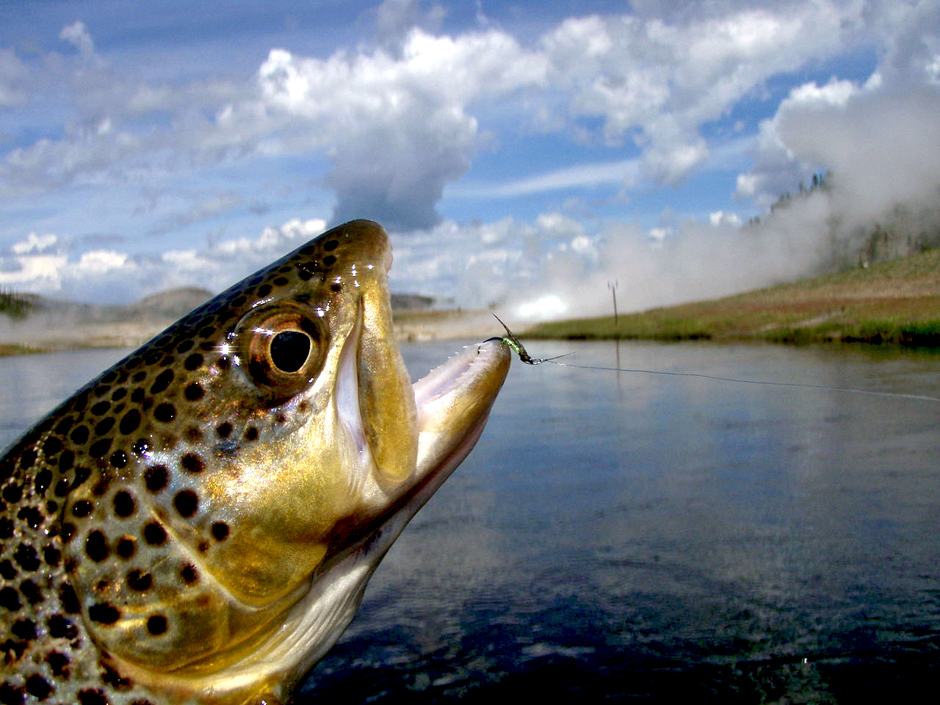Fish Behavior and Personality: Brown Trout
 Brown Trout having taken a soft-hackle nymph from the Firehole River, Yellowstone National Park (Released) (Credit: Mike Cline, Public Domain)
Brown Trout having taken a soft-hackle nymph from the Firehole River, Yellowstone National Park (Released) (Credit: Mike Cline, Public Domain)People have a knack for personifying just about anything that lives and breathes, but nothing seems to tickle us more than recognizing “human” personality types in non-human animals. The laid-back cat, the mischievous chimpanzee, the stubborn horse — but what about the adventurous fish?
It might not be the most intuitive idea to the average angler or goldfish owner, but new research from the University of Eastern Finland shows that personality type dictates whether brown trout are more or less willing to explore their environment. And it seems that the more curious the fish, the more likely it is to find itself hooked on a line. The study was published online ahead of print in the Canadian Journal of Fisheries and Aquatic Sciences.
“We were interested if angling would be selective with regard to fish behavior, as this question has been puzzling both fishers and researchers for quite some time already,” wrote researcher Laura Härkönen in an email with input from co-authors Juuso Paappanen and Anssi Vainikka. “If fishing kills only fish with certain personality, fishing might induce evolution of fish behavior. Fish might, for example, become more difficult to catch over time, as shown earlier in largemouth bass.”
Methods of Testing Fish Behavior
The researchers studied the behavioral personalities of brown trout raised in both standard hatcheries and an enriched hatchery that more closely emulates a natural rearing environment.
For the first part of the study, researchers released fish in a semi-natural channel and observed their behavior. Some fish proved more consistently active than others, swimming for long periods. Fish raised using traditional hatchery methods showed an aptitude for exploration, while others were less sure of their new surroundings. Additionally, many of the traditionally raised trout didn’t likely accept the natural food presented to them in the semi-natural environment and weakened over the course of the test.
The second half of the study gave the researchers an opportunity to tie some flies and see how the trout they had gotten to know so dearly would fare against a feathery lure at the end of a line. The researchers released the fish in experimental ponds with varying population densities at the Kainuu Fisheries Research Station. There, they fished and recorded the results of their catches. While it wasn’t quite a vacation, the location and work did make for an unorthodox experience.
Long Days and Losing Fish
“The study required long periods of time spent at the research station. The location is not that remote, but having no car, food and supplies had to be bought for several weeks at a time,” Paappanen wrote. “Having nothing else to do than eat, food supplies were consumed quickly and I had to resort to wild mushrooms, berries and fish caught from the nearby lake for a few days.”
In spite of that minor test of Paappanen’s survival skills, the researchers successfully gathered the data necessary to hone in on the particulars of angling vulnerability. One of the primary contributing factors to vulnerability was an individual’s propensity for exploration–a personality type observed most commonly in fish reared in traditional hatcheries. Body size didn’t seem to weigh too heavily on angling vulnerability, but changes in body condition–a sign of hunger–did.
Implications of Results
The study’s findings suggest that traditional hatcheries produce fish that are more vulnerable to angling and natural hazards than enriched hatcheries. Previous research has shown that traditional hatchery-raised fish are more susceptible to predation, as they aren’t familiar with predators. Their untempered curiosity and lack of familiarity with natural nutrition also puts those fish at a greater risk of biting into a tempting artificial fly.
Depending on your outlook (and perhaps your sense of sportsmanship), this discovery could be a blessing or a curse. Härkönen falls into the latter camp.
“For anglers, our results are a bit disappointing because they show that one doesn’t really need much skill to catch a hatchery fish,” Härkönen wrote. “They do not know what to eat and therefore actively seek to try almost everything.”
Informing Future Practice in Developing Fish Behavior
Releasing fish at a young age can offset some of the behavioral disadvantages imparted by traditional hatchery rearing, according to Härkönen. Early entry into their natural environment allows the fish to learn better habits in a natural setting. While large fish tend to attract more anglers, Härkönen suggests that stocking older individuals greatly hurts their chances of survival and could even be deemed unethical. She and her co-authors propose that hatchery managers incorporate more natural elements in their rearing tanks and possibly consider “training the fish for angling and predators.”
“We hope that the anglers and managers throughout the world would understand that nature is the best teacher for the fish,” Härkönen wrote. “If we need to compensate for our detrimental actions in the wild by releasing hatchery fish, we should raise the fish in as natural [an] environment as possible and use more actively their ability to learn before the release.”


0 comments